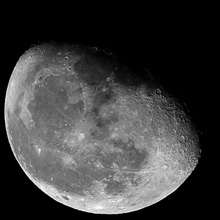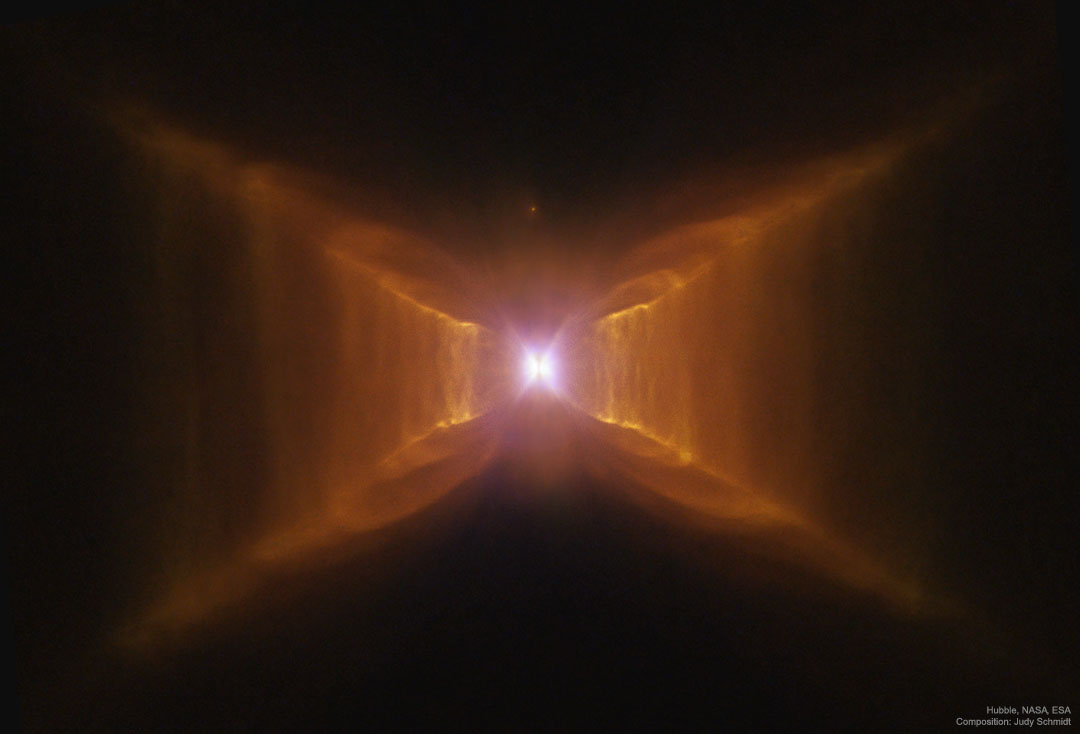How was the unusual Red Rectangle nebula created?
At the nebula's center is an aging
binary star system
that surely powers the nebula but does not, as yet, explain its colors.
The unusual shape of the
Red Rectangle
is likely due to a thick dust torus which pinches the otherwise spherical
outflow into tip-touching
cone shapes.
Because we view the torus edge-on, the boundary edges of the
cone shapes
seem to form an X.
The distinct rungs suggest the
outflow occurs in fits and starts.
The unusual colors of the nebula are
less well understood, however, and
speculation holds that they are partly provided by
hydrocarbon molecules that may actually be
building blocks for organic life.
The Red Rectangle nebula lies about 2,300
light years away
towards
the constellation of the Unicorn
(Monoceros).
The nebula is shown here in great detail as a reprocessed image from
Hubble Space Telescope.
In a few million years, as one of the central
stars becomes
further depleted of nuclear fuel,
the Red Rectangle nebula will likely
bloom into a
planetary nebula.
Astronomy.co.uk Star Naming Service
Name a star for yourself or for that special person as the perfect gift that will sparkle for a lifetime! Ideal for any occasion, birthdays, christenings, anniversaries and memorials. Reserve a place in the heavens for your loved ones
 Th Sky Tonight - May 2025
Th Sky Tonight - May 2025 https://www.astronomy.co.uk/the-sky-tonight/
https://www.astronomy.co.uk/the-sky-tonight/ The Pinwheel Galaxy -NASA
The Pinwheel Galaxy -NASA The first Full Moon of 2022, known as the Wolf Moon, will occur tonight! Throughout cold January nights, the howling of wolves could be heard around villages in both Europe and America, so the January Full Moon became widely known as the Wolf Moon.
The exact time of the Full Wolf Moon is January 17, 2022, 23:48 GMT
The first Full Moon of 2022, known as the Wolf Moon, will occur tonight! Throughout cold January nights, the howling of wolves could be heard around villages in both Europe and America, so the January Full Moon became widely known as the Wolf Moon.
The exact time of the Full Wolf Moon is January 17, 2022, 23:48 GMT The Lagoon Nebula - Hubble
The Lagoon Nebula - Hubble This is a small section of the Cygnus supernova blast wave which appears as a delicate streak of light.
Credit: ESA/Hubble & NASA, W. Blair; acknowledgment: Leo Shatz
This is a small section of the Cygnus supernova blast wave which appears as a delicate streak of light.
Credit: ESA/Hubble & NASA, W. Blair; acknowledgment: Leo Shatz An exploding star !
Hubble
An exploding star !
Hubble The station crew sees 16 sunrises a day, and they officially started 2022 at 12am GMT.
The station crew sees 16 sunrises a day, and they officially started 2022 at 12am GMT. The Snow Angel Nebula - Hubble
The Snow Angel Nebula - Hubble Crescent Earth
The Earth as seen from the Moon on the Command Module of Apollo17 on December 16, 1972.
Credit: @NASA (image #AS17-152-23274); Processing: @JPMajor
Crescent Earth
The Earth as seen from the Moon on the Command Module of Apollo17 on December 16, 1972.
Credit: @NASA (image #AS17-152-23274); Processing: @JPMajor Dolphin head nebula located near the center of the constellation Canis Major
Dolphin head nebula located near the center of the constellation Canis Major DEM L249, located in the Large Magellanic Cloud, is an unusual supernova remnant.
Image Credit: NASA, ESA, and Y. Chou (Academia Sinica, Institute of Astronomy and Astrophysics); Processing: Gladys Kober (NASA/Catholic University of America)
DEM L249, located in the Large Magellanic Cloud, is an unusual supernova remnant.
Image Credit: NASA, ESA, and Y. Chou (Academia Sinica, Institute of Astronomy and Astrophysics); Processing: Gladys Kober (NASA/Catholic University of America) The Prawn Nebula is a massive stellar nursery located in the constellation Scorpius, about 6,000 light years from Earth
Hubble
The Prawn Nebula is a massive stellar nursery located in the constellation Scorpius, about 6,000 light years from Earth
Hubble


